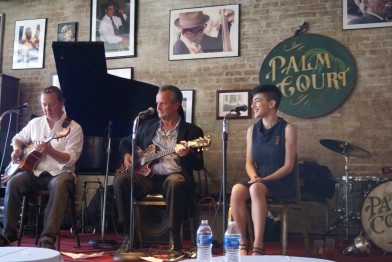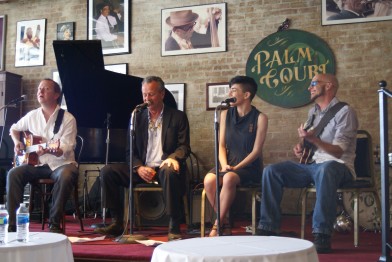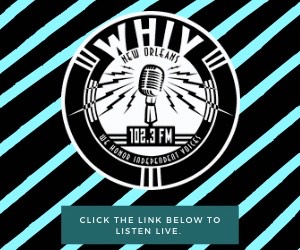Theater and literature weren’t the only things on the docket during the Tennessee Williams Literary Festival that took place around the French Quarter at the end of March.
The festival also featured some great music, including a spellbinding singer-songwriter showcase led by Paul Sanchez at the Palm Court Jazz Cafe on March 29.

Alex McMurray, Paul Sanchez, and Kimberly Kaye, perform songs from Nine Lives. Photo by Laura DeFazio
The set focused on Sanchez’ musical adaptation of Dan Baum’s 2009 book Nine Lives: Mystery, Magic, Death, and Life in New Orleans, underlining how literature, music, and theater can intertwine and complement one another in powerful ways.
Baum, a mostly-Colorado-based journalist, came down to New Orleans in the wake of Katrina to cover the story of a slowly-healing metropolis, and his intriguing interviews with people from all walks of life led him to dig deeper into the city’s backstory and underlying soul.
The result was Nine Lives, a vivid, multi-faceted memoir of the city between Hurricanes Betsy and Katrina told through the eyes of nine real citizens. It’s a compelling and impressive work, at once contradictory and perfectly honest, in the way that people’s true stories always are.
The “characters” cover the waterfront, from JoAnn (formerly John) Guidos, the trans owner of Kajun’s pub, to Frank Minyard, playboy/gynecologist-turned-charitable-coroner, to Joyce Montana, widow of the influential Big Chief Tootie Montana.
By the end, you feel as if you’ve gotten slightly more of a handle on the absurd, terrible, beautiful wonderland New Orleanians call home.
After reading the book, Sanchez (along with actor, writer, and lyricist Colman deKay) began working on a musical adaption, which eventually turned into a 39-track, two-volume song cycle (Nine Lives: A Musical Journey, released on Mystery Street Records.)
It features an all-star band: Alex McMurray (another of the city’s preeminent singer-songwriters), Irma Thomas, Shamarr Allen, John Boutte, Tom McDermott, Matt Perrine, and countless others.
The next step of the project was to shape it into a piece of musical theater, a sprawling, heavily-workshopped process undertaken by Sanchez, scriptwriter Kimberly Kaye, director Jim FitzMorris, producer Michael Cerveris, and scores of New Orleans musicians.
During the Tennessee Williams Festival, Sanchez, McMurray, and Kaye (a talented singer in addition to writer) performed several of the pieces they’ve been working so long on.
“JoAnn” was an energetic retelling of how Guidos provided shelter and protection to her “family” of neighborhood bar patrons in the wake of the storm (the chorus: “Thank God you’re not John anymore!”)
They also did “You and Me,” a haunting duo based on formerly-racist, poor-hating cop Tim Bruneau and the hallucinatory conversation he had with the corpse of Marie, a black neighborhood girl he found dead on Jackson Avenue and somehow couldn’t bear to leave.
“Could Have Been Worse” had been sung by Irma Thomas on the album, and Sanchez explained that wrote the song especially for her, based on the material she was singing in the 1960s when the scene takes place in the book.
He remembered that the first time Thomas ran through the piece with him, she was struck by how much it sounded like something she would have done back then.
But when they got to the bridge, he went on, she instinctively began tweaking words and altering melody lines. He found all of her changes to be completely spot on, and he gave her a songwriting credit on the album.
This was apparently something new for Thomas, even though she frequently made such adjustments to the material she was given.
Sanchez, for his part, was just happy to share a songwriting credit with Irma Thomas.
The trio performed a few songs from Sanchez’ other albums, like “Jet Black and Jealous” (off the album of the same name) and “Light It On Fire,” a spirited tune also off that album that was particularly compelling with McMurray and Kaye harmonizing.
McMurray delivered a surprise (for him, anyways) read-aloud of the segment of Kaye’s script about Bruneau and Marie, and then declined Sanchez’ request that that they do one of his own originals, opting instead for Danny Barker’s classic sing-a-long “Ham and Eggs” in honor of the late Palm Court mainstay.
WWOZ DJ Freddie “Blue” Goodrich joined them on guitar for the last number, a second line-style tune called “At the Foot of Canal Street” that Sanchez and John Boutte wrote after finding out their fathers had been buried right across from each other in the once-segregated white and black cemeteries at the foot of Canal Street.
This realization was the icing on the cake for the two close friends and musical collaborators, who spent most of their lives without crossing paths because of racial separation before realizing just how parallel their upbringings in New Orleans had been and how much they had in common.
The song began dirgelike and ended bursting with hope and elation, in the true spirit of New Orleans funerals.
All and all, it was an inspiring, uplifting show from three of the city’s great talents, speaking well of the Tennessee Williams festival, the Nine Lives project, and any of their original material.





